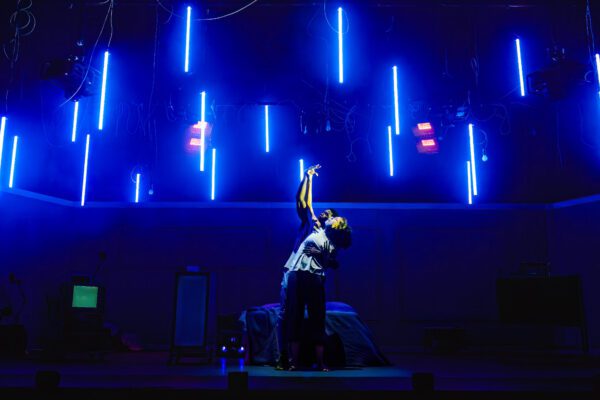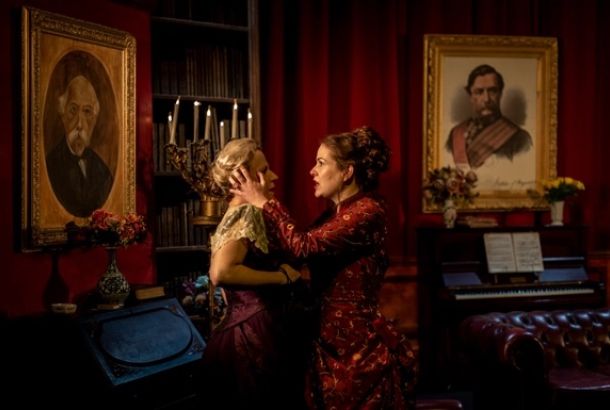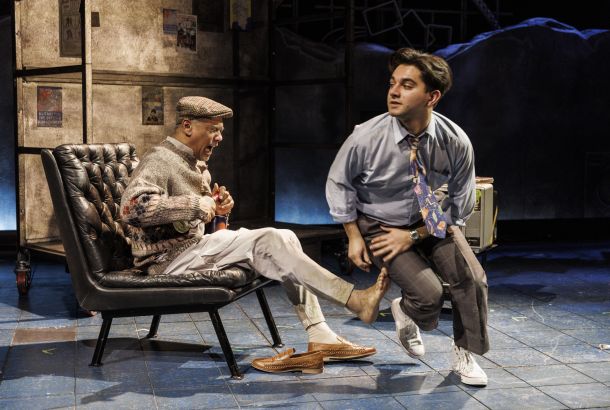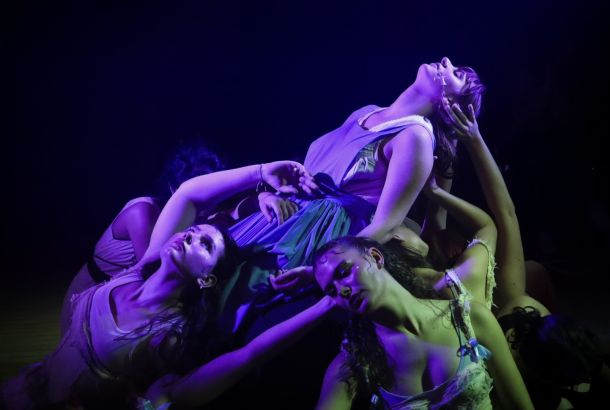Imitating the Dog’s Frankenstein review: A literally electric reimagination
By Rosina Read

I came to watch Imitating the Dog’s Frankenstein expecting a reintroduction to a text I studied at secondary school. Pathetic fallacy, romance, doppelgangers, and creation – all seen in earnest in Mary Shelley’s novel. But here, Imitating the Dog reimagines the story we were taught, introducing the audience to a couple in their flat – at this point, the audience may well wonder if they are in the right room.
Far from Shelley’s original text, which recounts the creation of Victor Frankenstein’s monster and its future implications, the play primarily follows the story of a couple grappling with pregnancy. The couple, seemingly forced together by this accident, (although their situation is never confirmed) debate the pros and cons of bringing life into the world. As the debate rages on, the couple metamorphoses at intervals into Shelley’s characters.
It is not easy to describe this play, and at times I’m even unsure who the actors are embodying. But a key takeaway seems to be the lack of clear doubles. Any direct parallels between the couple, the baby, and Shelley’s characters are constantly challenged, allowing instead for wider interpretations of what Frankenstein means to modern lives.
This constant flitting – a feeling exaggerated by lighting like a TV searching for channels between scenes – in some ways undermines the tension being built up in the individual scenes. It is easy to feel slightly jolted as at one moment the modern couple are making food for a homeless man and the next, Frankenstein is recounting the death of his family. However, as with the few comedic lines throughout the play, this serves more as a release for the audience than a real weakness. Similarly, the lighting and sound, at times so overwhelming that one has to look away, adds to the sense of tension and entrapment of all the characters; the play is not there to make us feel comfortable.
The second half maintains this feeling of entrapment. There are fewer transitions which creates a great connection to the characters, allowing for an emotive response that the first half somehow prevents. As we get to know the couple more, the woman (played by Georgia-May Myers) is brought to life through realistic and captivating acting. Nedum Okonyia’s character seems slightly less real in his narration and it is harder to fully understand his character after being made aware that this is a character being acted. However, it is in the scenes of Victor Frankenstein that Okonyia truly comes to life, through a captivating narration that accompanies a gradually weakening physicality.
From this play, one can take many messages that are relevant to the woes of the modern day. The focus on the choice, abortion, and bombings are topics clearly related to current affairs. At times, these messages can feel a little heavy-handed, such as in evocations of climate change in the ‘melting ice’, but they are nonetheless powerful.
Power is a predominant question throughout, although there never seems to be an answer to who has it. As the actors dance, they have no character and almost seem out of control of their own bodies. The play starts with the man handing the pregnancy test to his partner, but this male-dominated act isn’t necessarily maintained throughout. The presence of God, mentioned in the first words of the play, challenges any potential power for the characters. And then there is the classic power struggle in the narrative between Frankenstein and his monster: “You are my creator, but I am your master.”
The set itself is powerful. As one enters the auditorium, you are introduced to a grey set with two sole points of colour – the red radio and the blue, half-on screen. Technology scatters the room in screens, a disposed toaster, lamps, low-hanging lights; for audiences familiar with imitating the dog’s work, this is perhaps unsurprising, although their iconic live cameras are not used in this production. This set establishes the main constant in the play, electricity, which is then entwined with nature throughout, be it in images of contorted body forms or snow that looks more like static.

Despite the centrality of the bed, a constant reminder of the act of giving life, the radio is what is most central throughout the production. Acting as a red beating heart that rules the show, it is an almost constant source of noise. Throughout it is used in a range of ways: echoing the narrative, projecting howling winds, projecting news and shipping reports. To accompany the transition scenes which are often done through romantic, almost erotic, dancing, Mahler’s ‘Songs on the Death of Children’ is repeatedly played. The choice of music may seem obvious in hindsight, for its mentions of creation, weather, and bleakness that mirror the play, yet the creative details add to the all-encompassing feeling of the play.
The choice to end the production with the couple leaving the flat that has come to almost haunt the entire performance, and turn off the radio as it describes the thundery weather, suggests a final realisation that power and choice is limited, but within each of us. The electricity that has run through the play finally stops, allowing us to sit and reflect on the intense drama that has been created.
The production runs at the Lowry from March 12-14. It comes back to the UK after a run in Switzerland later this month.







